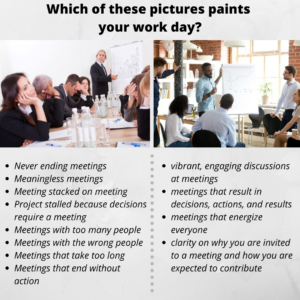I suspect that many of my readers can relate more to the meetings in the left column. I applaud my readers who are in a work environment described on the right – and encourage you to share some of the ways you create a meeting culture that works!
Meetings are a deep reflection of your organizational culture. When I walk into a client site and see numerous and overbooked conference rooms (you know – the ones that hold 8 to 20 people) – I see plenty of meetings in my future. When I try to book time for a 1-1 conversation with someone and I see their calendar double, triple or quadruple booked, I know I am in a culture that is not mindful with meetings. When I am working on an important project that gets stalled for two weeks until we can “get all the right people” in a meeting, I know that this is a project that is going to move at a snail’s pace.
Let me be clear – the need to get people together to plan, to coordinate, to consult, to inform, to collaborate is important. Perhaps more important than ever. I am not suggesting that meetings are the problem. We need places to bring people together to inform, to explore, to plan and to decide. Today’s environment may demand MORE ways to bring people together to do work. That may or may not mean traditional meetings.
The compelling question becomes this:
In a business environment where coordination and collaboration are increasingly important, how do we enable the right people to come together to do the right work in the right way?
I am not suggesting that we don’t meet. I am suggesting that we look at meetings with a business focused rigor, with an investment mentality and insist that the meetings we do have produce the desired outcomes while not consuming huge amounts of peoples’ time, energy, passion, skills, intellect and creativity.
Current research would indicate that you most likely spend between 35 to 50% of your time in your organization in meetings. The more senior your role, the more time you spend in meetings. Add to that the time it takes to prepare for the meeting, which accounts, on average for another 4 hours of work time per week, and meetings consume a vast amount of your working hours.
The old adage that “practice makes perfect” certainly does not apply to meetings. For something we do so much of, we can be so incredibly bad at meetings. In fact, executives report that as many of 67% of meetings are unproductive. An yet we go on and on and on. We schedule more meetings. And because they are unproductive, we multitask, making them even more unproductive. And because we didn’t effectively conclude the meeting with a decision or action item, we schedule another meeting. And the cycle continues and deepens.
I suspect we’ve all fallen into these meeting mishaps:
- The Monologue Meeting: where we invite lots of people and fail to engage them
- The Failure to Communicate Meeting: when we want to use a meeting to drive understanding – yet the content is delivered poorly, creating more confusion than clarity
- The “I’m Invisible” Meeting: where virtual participants are totally forgotten and ignored
- The Why Am I Here? Meeting: when we get to a meeting and have NO idea why we were invited
- The Endless Meeting – when we spend two hours in meeting when ten minutes would have sufficed; where we have to reschedule to get the work done or where the meeting runs over by hours
As with most things, it is easy to identify the problem and another thing to solve it. As such, my challenge to you is to focus on the places you have some control – the meetings that you either convene, lead, or attend.
In the meetings you either organize or participant in, I encourage you to:
- Be Bold
- Adopt an Investment Mentality
To Be Bold, I encourage you to take a stand. To be a bit counter cultural. To make the meetings you are a part of dramatically different. The reality is that organizational cultures change one person at a time. Can you be that brave person that challenges the meeting status quo in your organization and by doing so, encourages others to meet with purpose, with clarity and to take action? Can you be the person that holds meetings that others want to come to? Can you be that person who respects their own time enough to say no to meetings that are poorly planned, inefficient or ineffective?
To Adapt an Investment Mentality with meetings, you will create awareness of the true costs of meetings. You’ll be the one who evaluates the time and resource investment against the business outcome. You’ll challenge yourself and others to dramatically think about how many people attend meetings and who attends. You’ll help right size the meeting, eliminating extraneous people who can be spending their time more productively. You’ll begin to match real time requirements for the work at hand, rather than defaulting to the standard 60-minute meetings. You’ll create focus on real outcomes and cause others to think about meeting purpose and outcomes with a clearer lens.
The two challenges are outlined below. Give them a try….and share how it goes.
Challenge One: Be Bold: Radically Rethink Meetings (on-going)
In this challenge you will boldly focus on the meetings you lead and attend. You will take a stand, be a role model and raise the bar for others. They may or may not follow your lead, but you will, at a minimum, ensured that meetings work for you.
For meetings you are invited to:
- No Agenda and/or No Objectives: No Go!
Decline to participate in meetings you are invited to that merely ask for your time without explanation. Respond to these invites with a clear message that can go like this: Please provide me with the objective for this meeting and the role you need me to play in achieving that. Once I have that information, I’ll be able to make a good decision about my attendance.
- Be Clear About Your Declines
How many meetings have you been in where everyone was stalled waiting for those people who came late? At a minimum, everyone is delayed for 10 minutes attempting to ascertain if you are coming or not. Worst case, the meeting gets delayed because you are deemed a key decision maker for the outcome. If you are not going to attend, let the meeting organizer know at least one day in advance.
- Think in Fractions
Our default meeting time duration seems to be 60 minutes. Break that down into 15-minute increments and ask: Given what we need to accomplish do we need 15 minutes, 30 minutes, 45 minutes, 60 minutes or longer? Notice that this question puts what you want to accomplish at the center – and then the amount of time supports getting to the outcome you want.
- Create clarity real time.
I can guarantee that you will find yourself in meetings where you will be unclear about why you are there or what the purpose of the meeting is. In either case, raise your voice and ASK! If you are fuzzy on the decision or action item, speak up and help the group get there. By doing so, you’ll help yourself and you’ll also help others.
For meetings you organize:
- When you are considering inviting others to a meeting, ask these three questions:
- Is it necessary?
- Who needs to be there?
- How can I ensure it is productive, focused and interactive?
- Challenge yourself to have a minimalist mindset.
- Resist the urge to invite people. Pare down your list and invite the critical core then inform others that are interested in the topic via meeting notes
- Have mini-meetings. Use more 15 minutes stand up meetings or 30-minute meetings.
- Meeting Multiplication
Invest your time up front to maximize efficiency of other’s time. Plan your meetings well, even if that takes more time for you up front. Fifteen minutes of your time creating a solid agenda, clear objectives and a way to manage the meetings can result in maximizing a meeting. Those fifteen minutes may save 45 minutes for 12 others – which is a total of 9 hours saved because of your 15 minutes of up-front effort.
- Establish standard office hours to reduce your meeting time
If you are often pulled into meetings for your consultation or decision making, create and publicize a block of time that you are available for “drop by” conversations. People can stop and update you, get your input, or have you make a decision without schedule a formal meeting.
- Use the Kahn Academy Method
The Khan method flips classrooms into having students learn outside the classroom and then apply the learning in the classroom. Do the same for your meetings. Send the information before the meeting and then use the meeting to discuss and decide, rather than to inform.
- Be a Meeting Role Model
Of course, your meetings WILL have an agenda and outcomes and you’ll only invite those that have a true purpose to be there. Just taking this action will create a dramatic improvement for yourself – and others!
Challenge Two: Calculate the Cost and Make the Best Business Decision (10 minutes)
In this challenge you will get clear eyed and sober about the wage cost of meetings, which is rarely considered. I’ve seen businesses relentlessly pursue saving a hundred dollars here and a thousand dollars here, without ever asking how much meetings were costing in wages.
For example, a weekly 12-person one hour “team” meeting of mid-level professionals easily could cost $625 per meeting and is $32,500 per year in wage alone. This does not include fully loaded wage (with benefits, taxes, etc.) or the opportunity cost of what else could have been done in that time or the prep time or the disruption time.
This does not need to be an exact science. Even a benchmark number that helps us evaluate the cost of a meeting to its outcome can help us to make better decisions about our time.
How wonderful that HBR has an app for that! Use this calculator to get an idea of what the meetings you organize cost – and make decisions accordingly. You might even engage meeting participants with this question:
I’ve estimated that we’ve use XX hours of your time, with a rough calculation equates to $XXX. Given what we’ve accomplished, was this meeting time and money well spent? How could have we used our investment of time and money more wisely?
Resources I Recommend
The HBR Meeting Cost Calculator
If you are looking for tools to make the meetings you do have more productive, here is a great list of apps that can help.





